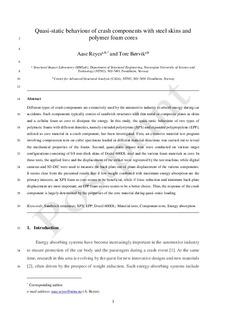| dc.contributor.author | Reyes, Aase | |
| dc.contributor.author | Børvik, Tore | |
| dc.date.accessioned | 2019-02-11T14:03:06Z | |
| dc.date.available | 2019-02-11T14:03:06Z | |
| dc.date.created | 2018-09-19T12:26:40Z | |
| dc.date.issued | 2018 | |
| dc.identifier.citation | Materials Today Communications. 2018, 17 541-553. | nb_NO |
| dc.identifier.issn | 2352-4928 | |
| dc.identifier.uri | http://hdl.handle.net/11250/2584843 | |
| dc.description.abstract | Different types of crash components are extensively used by the automotive industry to absorb energy during car accidents. Such components typically consist of sandwich structures with thin metal or composite plates as skins and a cellular foam as core to dissipate the energy. In this study, the quasi-static behaviour of two types of polymeric foams with different densities, namely extruded polystyrene (XPS) and expanded polypropylene (EPP), utilized as core material in a crash component, has been investigated. First, an extensive material test program involving compression tests on cubic specimens loaded in different material directions was carried out to reveal the mechanical properties of the foams. Second, quasi-static impact tests were conducted on various target configurations consisting of 0.8 mm thick skins of Docol 600DL steel and the various foam materials as core. In these tests, the applied force and the displacement of the striker were registered by the test machine, while digital cameras and 3D-DIC were used to measure the back-plate out-of-plane displacement of the various components. It seems clear from the presented results that if low weight combined with maximum energy absorption are the primary interests, an XPS foam as core seems to be beneficial, while if force reduction and minimum back-plate displacement are most important, an EPP foam as core seems to be a better choice. Thus, the response of the crash component is largely determined by the properties of the core material during quasi-static loading. | nb_NO |
| dc.language.iso | eng | nb_NO |
| dc.publisher | Elsevier | nb_NO |
| dc.rights | Attribution-NonCommercial-NoDerivatives 4.0 Internasjonal | * |
| dc.rights.uri | http://creativecommons.org/licenses/by-nc-nd/4.0/deed.no | * |
| dc.title | Quasi-static behaviour of crash components with steel skins and polymer foam cores | nb_NO |
| dc.title.alternative | Quasi-static behaviour of crash components with steel skins and polymer foam cores | nb_NO |
| dc.type | Journal article | nb_NO |
| dc.type | Peer reviewed | nb_NO |
| dc.description.version | acceptedVersion | nb_NO |
| dc.source.pagenumber | 541-553 | nb_NO |
| dc.source.volume | 17 | nb_NO |
| dc.source.journal | Materials Today Communications | nb_NO |
| dc.identifier.doi | 10.1016/j.mtcomm.2018.09.015 | |
| dc.identifier.cristin | 1610997 | |
| dc.relation.project | Norges forskningsråd: 237885 | nb_NO |
| dc.description.localcode | © 2018. This is the authors’ accepted and refereed manuscript to the article. Locked until 19.9.2020 due to copyright restrictions. This manuscript version is made available under the CC-BY-NC-ND 4.0 license http://creativecommons.org/licenses/by-nc-nd/4.0/ | nb_NO |
| cristin.unitcode | 194,64,45,0 | |
| cristin.unitname | Institutt for konstruksjonsteknikk | |
| cristin.ispublished | true | |
| cristin.fulltext | postprint | |
| cristin.fulltext | original | |
| cristin.qualitycode | 1 | |

